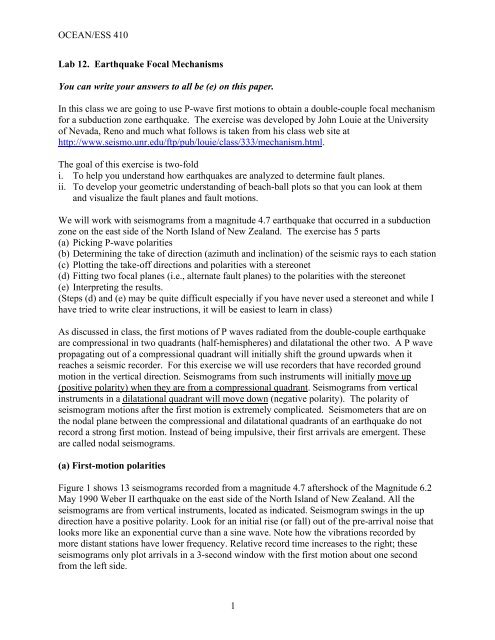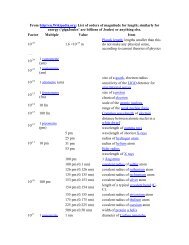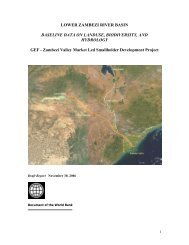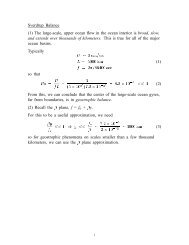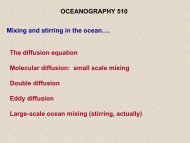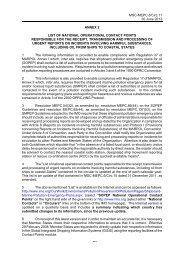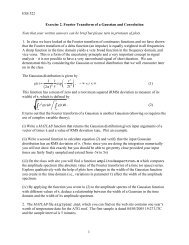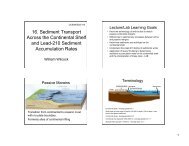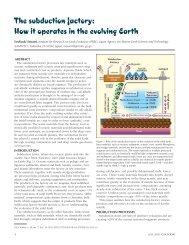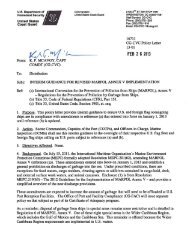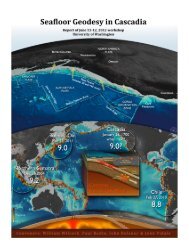OCEAN/ESS 410 1 Lab 12. Earthquake Focal Mechanisms You can ...
OCEAN/ESS 410 1 Lab 12. Earthquake Focal Mechanisms You can ...
OCEAN/ESS 410 1 Lab 12. Earthquake Focal Mechanisms You can ...
Create successful ePaper yourself
Turn your PDF publications into a flip-book with our unique Google optimized e-Paper software.
<strong>OCEAN</strong>/<strong>ESS</strong> <strong>410</strong><strong>Lab</strong> <strong>12.</strong> <strong>Earthquake</strong> <strong>Focal</strong> <strong>Mechanisms</strong><strong>You</strong> <strong>can</strong> write your answers to all be (e) on this paper.In this class we are going to use P-wave first motions to obtain a double-couple focal mechanismfor a subduction zone earthquake. The exercise was developed by John Louie at the Universityof Nevada, Reno and much what follows is taken from his class web site athttp://www.seismo.unr.edu/ftp/pub/louie/class/333/mechanism.html.The goal of this exercise is two-foldi. To help you understand how earthquakes are analyzed to determine fault planes.ii. To develop your geometric understanding of beach-ball plots so that you <strong>can</strong> look at themand visualize the fault planes and fault motions.We will work with seismograms from a magnitude 4.7 earthquake that occurred in a subductionzone on the east side of the North Island of New Zealand. The exercise has 5 parts(a) Picking P-wave polarities(b) Determining the take of direction (azimuth and inclination) of the seismic rays to each station(c) Plotting the take-off directions and polarities with a stereonet(d) Fitting two focal planes (i.e., alternate fault planes) to the polarities with the stereonet(e) Interpreting the results.(Steps (d) and (e) may be quite difficult especially if you have never used a stereonet and while Ihave tried to write clear instructions, it will be easiest to learn in class)As discussed in class, the first motions of P waves radiated from the double-couple earthquakeare compressional in two quadrants (half-hemispheres) and dilatational the other two. A P wavepropagating out of a compressional quadrant will initially shift the ground upwards when itreaches a seismic recorder. For this exercise we will use recorders that have recorded groundmotion in the vertical direction. Seismograms from such instruments will initially move up(positive polarity) when they are from a compressional quadrant. Seismograms from verticalinstruments in a dilatational quadrant will move down (negative polarity). The polarity ofseismogram motions after the first motion is extremely complicated. Seismometers that are onthe nodal plane between the compressional and dilatational quadrants of an earthquake do notrecord a strong first motion. Instead of being impulsive, their first arrivals are emergent. Theseare called nodal seismograms.(a) First-motion polaritiesFigure 1 shows 13 seismograms recorded from a magnitude 4.7 aftershock of the Magnitude 6.2May 1990 Weber II earthquake on the east side of the North Island of New Zealand. All theseismograms are from vertical instruments, located as indicated. Seismogram swings in the updirection have a positive polarity. Look for an initial rise (or fall) out of the pre-arrival noise thatlooks more like an exponential curve than a sine wave. Note how the vibrations recorded bymore distant stations have lower frequency. Relative record time increases to the right; theseseismograms only plot arrivals in a 3-second window with the first motion about one secondfrom the left side.1
<strong>OCEAN</strong>/<strong>ESS</strong> <strong>410</strong>Circle the first motion on each one (do not obscure the wiggles with your pen). Identify whethereach first motion is compressional, dilatational, or nodal, and write your identification to theright of each seismogram and in the Table at the end of this exercise.(b) Ray take-off directionsBecause seismic velocities generally change with depth (and often with horizontal position), it isgenerally necessary to use a computer code that calculates ray path that obey Snell’s Law.However, for this earthquake the rays <strong>can</strong> be approximated as straight lines between theearthquake and the seismic stationsFigure 2 shows a map of the stations and the earthquake.(i) Use a protractor to measure the azimuth between the earthquake epicenter and the seismicstations and record it in the Table at the end of this exercise. The azimuth is measured in degreesclockwise from North (it <strong>can</strong> vary between 0° and 360°).(ii) Calculate a scale from the map and use this to measure the horizontal distances in kilometersbetween the earthquake epicenter and the seismic stations. Record these in the table.(iii) To get a ray’s inclination (Θ in the figure below), use the horizontal distance you havemeasured from the earthquake's epicenter to the recording station, and the earthquake's 16.7 kmdepth. The depth divided by the distance is the tangent of the inclination. Take the inversetangent (arctangent) of this quantity to get the inclinations. Record these in the table.(c) Plotting polarities on the focal sphereThe next step is to use a stereonet to plot the takeoff directions. When we plot the take offdirections as points that mark the intersection of the ray with a sphere with the earthquake at itscenter. The Wolff stereographic projection provides a means to project points on the surface of asphere onto a disk and to project the great circle lines that are formed by any plane that dividesthe sphere into two hemispheres. The stereonet is attached as Figure 3 to this exercise.The stereonet grid has a spacing of 2°. Points that plot around the rim of the stereonet representhorizontal take off directions (Θ = 0°) with the azimuth as shown. As one moves towards the2
<strong>OCEAN</strong>/<strong>ESS</strong> <strong>410</strong>(e) InterpretationTo make your interpretation, it may help you to know that the Weber II earthquake sequence isabove a shallow zone of westward subduction, that the subduction zone strikes northeast, andthat the Weber II aftershocks align along a northwest-dipping plane (see figure below).(i) What are the strikes and dips of the two focal planes(ii) Draw a NW-SE cross-section through your solution showing the two possible orientations ofthe fault plane and the motions on each. Which is most compatible with the tectonics of theregion.In this exercise we have been using an upper hemisphere projection (i.e., projecting rays thatwere taking off upwards on the stereonet). For large teleseismic earthquakes recorded by globalseismic networks, the stations are 100’s and 1000’s of kilometers from the earthquake and therays take off downwards. The focal mechanisms for teleseismic and regional earthquakes arenearly always plotted with a lower hemisphere projection.(iii) Sketch what your focal mechanism would look like using a lower hemisphere projection.Remember that the polarity at the opposite point on the sphere will always be the same. This ishard so look at your ping-pong ball and if you get confused, talk to the instructor or TA. (Ifyour solution is symmetric and does not change for the lower hemisphere sketch an example ofone that is asymmetric and draw its lower and upper hemisphere projection).4
Weber II Aftershock 127786, North Island, New Zealand 1990/05/1700:57 UTC Lon=176.3284° Lat=-40.2295° Depth=16.7 km Mag=4.731Lon=176.35° Lat=-40.250° dist=3.4 km2Lon=176.17° Lat=-40.292° dist=14.4 km3Lon=176.37° Lat=-40.061° dist=19.1 km4Lon=176.28° Lat=-40.408° dist=20.2 km5Lon=176.06° Lat=-40.106° dist=25.9 km6Lon=176.47° Lat=-40.453° dist=28.0 km7Lon=176.63° Lat=-40.339° dist=29.1 km8Lon=176.09° Lat=-40.429° dist=29.9 km9Lon=176.27° Lat=-40.618° dist=43.5 km10Lon=176.81° Lat=-39.989° dist=49.0 km11Lon=176.35° Lat=-39.699° dist=59.0 km12Lon=176.88° Lat=-39.665° dist=78.4 km13Lon=176.82° Lat=-39.541° dist=87.5 km-1 Time, sec2Figure 1
Weber II Aftershock Records-39.61311 12-39.8Latitude-40.0-40.25310-40.4824167-40.69175.8 176.0 176.2 176.4 176.6 176.8 177.0LongitudeFigure 2
<strong>OCEAN</strong>/<strong>ESS</strong> <strong>410</strong>Figure 38


